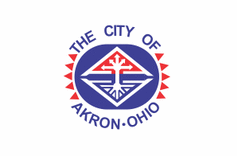|
The rules state: 1) Keep It Simple, 2) Use Meaningful Symbolism, 3) Use 2 to 3 Basic Colors, 4) No Lettering or Seals, 5) Be Distinctive or Be Related.
According to the rules of vexillology enthusiast Roman Mars, the Akron’s flag isn’t great. It's basically a seal, has too many letters on it, and no child can easily draw it (mainly because of the lettering). I actually love the 1965 flag, just get rid of the words. Why am I talking about flags? Because they are important to us! Flags hanging prominently from homes, tell us about the residents’ politics, heritage, and social groups. Flags are treated with care, with special rules about proper flying, folding, and disposing. To mistreat a flag is to invite others’ anger. They are the quintessential symbolic object, serving no other purpose than to state an opinion and point to the values for which they stand. There are many objects in our world that are purely symbolic, many more that also serve practical purposes. Perhaps the most ubiquitous symbol today is the cross. We see them everywhere! Combined with other common Christian symbols, their absence in a home speaks louder than their presence. So, why did our Anabaptist ancestors avoid the usage of symbols, even the cross? Visit a traditional Brethren meeting house and you’ll notice there is no cross, pictures, or high communion table (altar). Just wooden pews surroundings a single long wooden table and a stove for cooking and heating. Of course it is also symbolic, an open rejection of the ornate, worldly styles of other sanctuaries. Jesus spends a lot of time reminding us about the dangers of becoming sidetracked in this world. He chided the rich for their trust in material, the Pharisees and Sadducees who held the Law above all else, and his disciples for believing in a nation conquering messiah. They had lost their way, instead of worshipping and trusting in God, they put their faith in wealth, religion, and power. They created idols. We don’t use the word idolatry a lot today, but we are as guilty of putting our faith in worldly things as the ancients. Our Anabaptist forerunners not only saw the ornate, symbolic decor of churches as counter to the simple life of Jesus’s Way, but as idolatry, or as a gateway into the sin. Though today our worship spaces aren’t as simple, we still tend to be plainer than our neighbors. My musings on symbolism began because this is Lent and we are approaching the cross, our most common symbol. It points us towards Jesus, towards the Kingdom. But the forerunners remind us that it is still just two pieces of wood and its purpose is only to point to the Messiah who conquered it. We need to be careful to not get lost in worldly things and put symbolic actions above compassionate ones. That our eyes should alway be focussed beyond to Jesus. So as we journey towards the Easter, let’s not worry about signaling our faith the Christ through symbols and symbolic actions. Instead, let’s show His Way through our meaningful actions and relationships. Jesus calls us to move forward with complete faith in God, living as members of the Kingdom of Heaven in a world that hasn’t called caught up yet. Perhaps, by living the way we are called more purely, we can get the world a little closer yet. Sources: Kohlstedt, Kurt. “Vexillology Revisited: Fixing the Worst Civic Flag Designs in America.” 99 Percent Invisible. Feb. 2, 2016. https://99percentinvisible.org/article/vexillology-revisited-fixing-worst-civic-flag-designs-america/ Wyatt, Rick. “Akron, OH.” Flags of the World. July 27, 2018. https://www.crwflags.com/fotw/flags/us-oh-ak.html
0 Comments
|
Details
Pastor AndrewLetters from the monthly newsletter. Archives
May 2024
Categories |
We Would Love to Have You Visit Soon!
|
Sunday Worship10:30 am
|
Telephone |
|


 RSS Feed
RSS Feed
